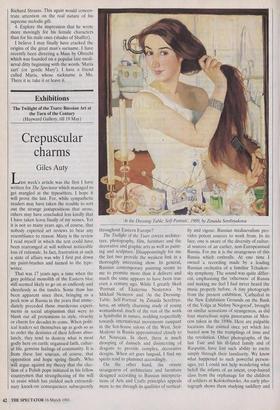Exhibitions
The Twilight of the Tsars: Russian Art at the Turn of the Century (Hayward Gallery, till 19 May)
Crepuscular charms
Giles Auty
Last week's article was the first I have written for The Spectator which managed to get mangled at the typesetters. I hope it will prove the last. For, while sympathetic readers may have taken the trouble to sort out the strange juxtapositions that arose, others may have concluded less kindly that I have taken leave finally of my senses. Yet it is not so many years ago, of course, that nobody expected art reviews to bear any resemblance to reason. Many is the review I read myself in which the text could have been rearranged at will without noticeable loss of rationale. In fact, frustration at such a state of affairs was why I first put down my paint-brushes and turned to the type- writer.
That was 17 years ago, a time when the grey political monolith of the Eastern bloc still seemed likely to go on as endlessly and cheerlessly as the tundra. Some thaw has been apparent since then, bringing us a peek now at Russia in the years that imme- diately preceded those murderous experi- ments in social utopianism that were to blank out all pretensions to style, vivacity or charm for decades to come. When polit- ical leaders set themselves up as gods so as to order the destinies of their fellows abso- lutely, they tend to destroy what is most godly here on earth: organised faith, cultur- al life, genuine feelings of community. It is from these last sources, of course, that opposition and hope spring finally. Who will argue against my theory that the elec- tion of a Polish pope initiated in his fellow countrymen that strengthening of the will to resist which has yielded such extraordi- nary knock-on consequences subsequently 't the Dressing-Table: Self: Portrait 1909, by Zinaida Serebtyakova
throughout Eastern Europe?
The Twilight of the Tsars covers architec- ture, photography, film, furniture and the decorative and graphic arts as well as paint- ing and sculpture. Disappointingly for me the last two provide the weakest link in a thoroughly interesting show. In general, Russian contemporary painting seems to me to promise more than it delivers and much the same appears to have been true even a century ago. While I greatly liked 'Portrait of Ekaterina Nesterova' by Mikhail Nesterov and 'At the Dressing- Table: Self-Portrait' by Zinaida Serebrya- kova, an utterly charming study of young womanhood, much of the rest of the work is Symbolist in nature, nodding respectfully towards international movements rampant in the hot-house salons of the West. Style Moderne in Russia approximated closely to Art Nouveau. In short, there is much drooping of damsels and disinterring of dragons to provide complex, decorative designs. When art goes languid, I find my spirits tend to plummet accordingly.
On the other hand, the ornate strangeness of architecture and furniture designed according to Russian interpreta- tions of Arts and Crafts principles appeals more to me through its qualities of vertical- ity and vigour. Russian mediaevalism pro- vides potent sources to work from. In its face, one is aware of the diversity of cultur- al sources of an earlier, non-Europeanised Russia. For me it is the strangeness of this Russia which enthralls. At one time I owned a recording made by a leading Russian orchestra of a familiar Tchaikov- sky symphony. The sound was quite differ- ent, emphasising the 'otherness' of Russia and making me feel I had never heard the music properly before. A tiny photograph from the present exhibition, 'Cathedral in the New Exhibition Grounds on the Bank of the Volga at Nizhny Novgorod', brought on similar sensations of strangeness, as did four marvellous sepia panoramas of Mos- cow taken in the 1890s. Here are palpable locations that existed once yet which are buried now by the tramplings of time and the revolution. Other photographs, of the last Tsar and his ill-fated family and of Rasputin, have lost such ability to excite simply through their familiarity. We know what happened to such powerful person- ages, yet I could not help wondering what befell the infants of an intent, crop-haired class from the orphanage for the children of soldiers at Kolokoltsovko. An early. pho- tograph shows them studying saddlery and
shoemaking. How intriguing it would be to read a diary written by any one of them.
For me, a large part of the charm of the present show is in the stirring up it pro- vokes of historical imaginings. Perhaps to ponder what might have been and what is in Russia is fruitless. Yet in the light of so much that has happened in the past 80 years, it is hard not to do so.



























































 Previous page
Previous page